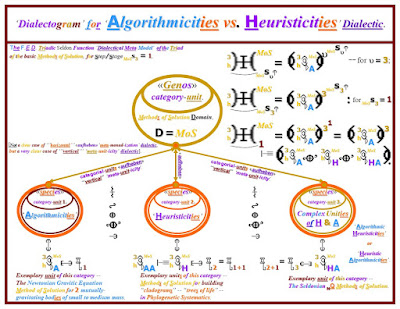CHARLES Fourier’s ‘‘‘Series-ism’’’ -- ¿Precursor/Anticipation of the Seldonian Dialectic?
Dear Reader,
FYI: A
passage from a new, 2017 book on Marx’s «Das Kapital»
has “caught the eye” of the Foundation Encyclopedia
Dialectica [F.E.D.] research community, with a
passage on its page 36.
This passage intimates the existence of a Fourierist, and
Proudhonist, ‘serial laws’ anticipation of the Seldonian Dialectic, one that
may have also influenced Marx in his ‘‘‘systematic-dialectical’’’ construction of «Das
Kapital».
More specifically, this passage
intimates that the Fourierist and Proudhonist concepts of ‘serial laws’
may have anticipated the multi-categorial, ‘poly-qualinomial’ “series” ‘qualitative
superpositionings’ [“superpositions” or “sums” of qualitatively
differing terms
-- not of “purely” quantitative terms, as per JOSEPH Fourier’s famous
series], or “non-amalgamative
sums”
-- i.e., the ‘multi-ontic
cumula’
-- of ontological-category-representing symbols, as generated by a ‘‘‘Seldon Function’’’ -- i.e., by a, 'self-iterated', ‘self-reflexive
function’ of an «arché» ontological category.
I have reproduced this whole passage, including its
footnotes, below.
Elements of the F.E.D.
research community are now
seeking to corroborate, or to falsify, the claims of this passage.
The book is: Marx’s
Inferno: The Political
Theory of Capital, by William Clare Roberts, Princeton: Princeton University Press, 2017.
The findings of the
F.E.D. research on the claims of
this passage -- one way or another -- are likely to influence the further
development of the content of the
www.dialectics.info
methodology page --
Dialogically Yours,
Miguel Detonacciones,
Member, Foundation Encyclopedia
Dialectica [F.E.D.],
Officer, F.E.D. Office of Public Liaison.
[pp. 36-37:] “There
are in Proudhon’s writings of the 1840s numerous invocations of the promise of
an economic science that would reveal the tendency toward order in human
society and catalyze the development of that order.60”
“In Qu’est-ce que la propriété? he summed up this
prospective development by coining a phrase that would have a long life as
another socialist myth: “the sovereignty
of the will gives way to the sovereignty of reason and ends up being replaced
by a scientific socialism.”61”
“Proudhon’s notion of this incipient social science was
heavily indebted to Charles Fourier’s conception of the “series,”62 the sum of an
ordered succession of elements.63”
“The underlying idea is
that the successive “stages”
or “periods” (époques) of
history exhibit, in turn,
successive principles, and that only at the end of the series will these
opposed principles come into a harmonious interrelation.” [Emphases added
by M.D.].
“As Proudhon put it, “while in nature the synthesis of
contraries is contemporaneous with their opposition, in society the antithetic
elements seem to be produced at long intervals, and to be resolved only after
long and tumultuous agitation.”64”
“Because science
is supposed to grasp the series, it must proceed through the elements of the
series in turn, showing how any partial summation of the series, including any
element on its own, is self-contradictory and inadequate from the point of view
of justice.”
“Hence, science, in Proudhon’s sense must proceed
methodically, following a determinate path, and may be said to pass from
appearances -- the partial aspects of the world presented by each époque
-- to the reality of the whole series.”
“As Proudhon put it, “to explain the system of the world, .
. . one must leave the circle of appearances.”65”
“This was the task Proudhon tried to accomplish in his Système.”
_______________________________________________________________________________
“60For examples,
see What Is Property?, 17-20, 208-11; OC [«Oeuvres Complètes»; the
Complete Works of Proudhon], 4:136-41,
338-42; System [System of
Economical Contradictions: Or, the Philosophy of Poverty.],
1:44, 55, 388-97; OC, 1:66, 75, 337-44; OC, 5:80-100, 405-51.”
“61What
Is Property?, 208-9; OC, 4:339.”
“62Coincidentally, there were two Fouriers
obsessed with series: Charles, and the
mathematician Joseph. Victor Hugo, in Les Misèrables, wrote that “There was a celebrated Fourier, at the Academy of
Science, whom posterity has forgotten; and in some garret an obscure Fourier,
whom the future will recall” (I.III.1).
This prediction has turned out to be very nearly the opposite of the
truth, as the Fourier series is integral to mathematics [and to contemporary physics
-- M.D.] while the other series,
and the other Fourier, if not forgotten, certainly have no import in the social
sciences [the
latter being, at least in part, a critique of the contemporary, ruling class
ideologically-engineered, so-called “social” “sciences”, i.e., the capitalist
ideologies of ‘linearoid’, ‘individualoid’ atomism, reflecting the profound mutual
alienation among selves, and the self-alienation, that vitiates human sociality, and
human solidarity, in the modern, capitalist époque -- M.D.].”
“63Hoffman,
Revolutionary Justice, 106-9; Crowder, Classical Anarchism, 112.”
“64System,
1:129-30; OC, 1:135; compare What Is Property?, 19; OC,
4:19.”
“65What
Is Property?, 18; OC, 4:138.
Proudhon’s self-conception as a scientist has not aged well. Even scholars very friendly to Proudhon, claim,
e.g., that Proudhon’s “‘synthesis’ is quite artificial, claiming that it
integrates without really doing so.” (Hoffman, Revolutionary Justice,
109). Indeed, Proudhon himself may have
been dissatisfied with this pretense for he largely dropped his claims to
science after the disappointing reception of De la creation de l’ordre
and Système des contradictions (Crowder, Classical Anarchism,
112). There was, however, no point at
which Proudhon either gave up his notion of historical development or his
valorization of science as the outcome of that historical development.”














